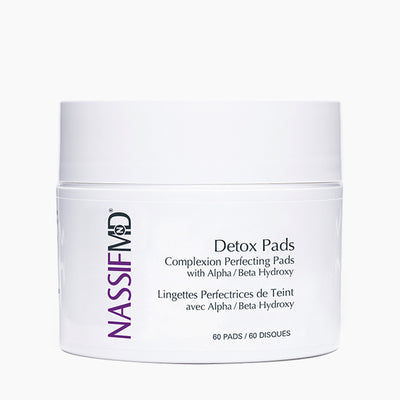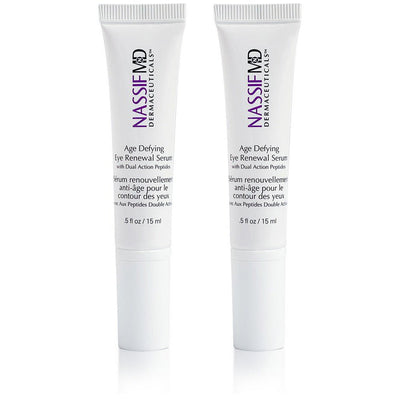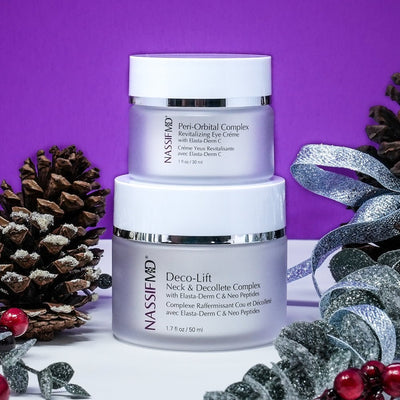What Causes Enlarged Pores and How to Get Rid of Them
Beauty culture tells us visible pores are undesirable, and we shouldn’t have them. Often, pores are airbrushed out of photos and video. But the truth is that people have texture to their skin. Pores are normal, natural, and serve a purpose.
We can’t “get rid” of pores, which is a good thing because we need pores for healthy skin. However, we can reduce the appearance of pore size with our skincare routine. Keep reading to find out how.
Today’s article will cover:
- What are pores?
- Causes of enlarged pores
- How to “get rid” of enlarged pores, i.e., how to minimize the appearance of pores
What are Pores?
Pores are natural openings in the skin that can be visible or invisible. They tend to be more visible on the cheeks and nose, appearing as circular openings or dots. Visibility of pore size primarily has to do with pore volume.
Pores release sweat, which is vital for temperature regulation and detoxification. Pores also produce sebum, the skin’s natural oil, which keeps the skin soft and helps maintain barrier function. Open, unclogged pores are necessary for healthy skin.
What Causes Enlarged Pores?
Enlarged pores, although benign, are a common cosmetic and dermatological concern. Many people seek treatment to reduce pore size.
Let’s look at some of the causes and contributing factors to the appearance of large pores.
Genetics
Pores have a genetic component, and a part of your pore size and appearance is inherited. Those with decreased elasticity around their pores, increased size of hair follicles (thick hair), and excess sebum (oily skin) may have larger pores. Men also tend to have larger pores than women.
We all have unique bodies and characteristics, and pore size and appearance are very individual.
Aging
Aging skin is another underlying factor in the appearance of large pores. With age comes a loss of collagen and elastin, the protein structures responsible for firm skin. A decline in the skin structure leads to sagging, making pores stretch and appear more prominent.
With age also comes more sun exposure and damage.
Sun Damage
Sun damage contributes to enlarged pores. UV radiation causes free radical damage and a breakdown of collagen, which can cause pores to lose their structure and appear larger.
For more information on sun damage, please read How to Prevent and Treat Sun Damaged Skin.
Dirt & Oil Buildup
Dirt, oil, makeup, dead skin cells, excess sebum (sebaceous filaments), and sweat can clog pores, making them appear larger. Oil buildup and clogged pores may be more common in those with oily or acne-prone skin. It’s common to have more oil in the T-zone, forehead, nose, and chin, where pores appear bigger.
How to “Get Rid” of Enlarged Pores
As much as you want to close, hide, or get rid of pores, you can’t make them disappear. Your pores serve the important functions of releasing sweat and sebum. Still, you can use good skincare habits to keep your pores clean and make them appear smaller.
Use a Gentle Cleanser
The first step in a pore-minimizing skincare routine is to use a gentle facial cleanser. Clean pores look smaller. You want to clean the skin of dirt, makeup, and other impurities without stripping moisture or oils.
Wash your face twice daily, morning and night, with warm water to help open and clean out pores.
Select Non-Comedogenic Products
Non-comedogenic products are water-based products that won’t clog your pores. Avoiding comedogenic (oil-based) products is helpful, especially if you have oily skin or enlarged pores.
Moisturize & Maintain Skin Hydration
Skin hydration enhances the structure and elasticity of the skin, helping pores to look smaller. Hydration is crucial for all skin types, including oily skin.
It’s helpful to use a topical moisturizer to enhance the skin moisture barrier and prevent water loss. Avoid the long-term use of products that dry out the skin, as dry skin contributes to the appearance of larger pores.
In addition, support hydration internally by drinking water and eating hydrating foods. Read more about nutrition and skin hydration here.
Use Chemical Exfoliants & Don’t Over Exfoliate
Gentle chemical exfoliants include natural hydroxy acids like phytic acid found in plants. Chemical exfoliants remove dead skin cells and impurities on the skin’s surface, allowing new skin cells to regenerate.
A physical exfoliant can also have the same effect. An example of a gentle option is the Ecuadorian ivory palm tree. Small amounts in a cleanser scrub the skin’s surface to remove dead skin cells and help unclog pores gently.
Read more about the different types of exfoliants in How to Find the Perfect Exfoliator for Your Skin Type.
When working to reduce the appearance of pores, avoid over-exfoliation. Too much exfoliation can lead to dry skin, making pores look bigger. In turn, dry skin leads to increased sebum production, and too much sebum also affects the appearance of pores.
Protect Your Skin from UV Rays
Sun damage is drying, accelerates aging, and makes pores look more prominent. Sun protection is essential for skin health and reduced pore size. Use a quality daily sunscreen, ideally with mineral-based sun protection.
Good skincare habits make a world of difference regarding how your pores look. NassifMD® Dawn to Dusk AM + PM Facial Cleanser and NassifMD® Protect & Hydrate Daily Mineral Sunscreen top the list of essential pore-friendly products to add to your skincare routine.
NassifMD® Dawn to Dusk AM + PM Facial Cleanser is an exfoliator and cleanser in one. It contains phytic acid and Ecuadorian ivory palm to exfoliate and promote cellular turnover. In fact, it’s gentle enough to use morning and night.
This dual-action cleanser deeply cleanses without stripping the skin of moisture and uses jojoba as an emollient to keep skin soft and supple. The result is smooth, radiant skin and pores that look smaller and refined.
NassifMD® Protect & Hydrate Daily Mineral Sunscreen is a daily moisturizer with SPF 44 and antioxidants to protect the skin against sun damage, pollution, and other sources of free radicals. It provides hyaluronic acid for hydration, vitamin C and palmitic acid for antioxidants, along with zinc oxide for natural UV protection.
Combined, the ingredients in NassifMD® Protect & Hydrate work synergistically to minimize the appearance of pores. In addition, this formula is lightweight, oil-free, and effective.
While you can’t make your pores go away, there are several skincare strategies to help minimize the appearance of your pores and let your natural beauty shine through. It may be as simple as adding a dual-action cleanser and SPF moisturizer to your skincare routine!
References
- Uhoda, E., Piérard-Franchimont, C., Petit, L., & Piérard, G. E. (2005). The conundrum of skin pores in dermocosmetology.Dermatology (Basel, Switzerland), 210(1), 3–7.
- Flament, F., Francois, G., Qiu, H., Ye, C., Hanaya, T., Batisse, D., Cointereau-Chardon, S., Seixas, M. D., Dal Belo, S. E., & Bazin, R. (2015). Facial skin pores: a multiethnic study.Clinical, cosmetic and investigational dermatology, 8, 85–93.
- Kim, S. J., Shin, M. K., Back, J. H., & Koh, J. S. (2014). Pore volume is most highly correlated with the visual assessment of skin pores.Skin research and technology : official journal of International Society for Bioengineering and the Skin (ISBS) [and] International Society for Digital Imaging of Skin (ISDIS) [and] International Society for Skin Imaging (ISSI), 20(4), 429–434.
- Dong, J., Lanoue, J., & Goldenberg, G. (2016). Enlarged facial pores: an update on treatments.Cutis, 98(1), 33–36.
- Lee, S. J., Seok, J., Jeong, S. Y., Park, K. Y., Li, K., & Seo, S. J. (2016). Facial Pores: Definition, Causes, and Treatment Options.Dermatologic surgery : official publication for American Society for Dermatologic Surgery [et al.], 42(3), 277–285.
- Hameed, A., Akhtar, N., Khan, H. M. S., & Asrar, M. (2019). Skin sebum and skin elasticity: Major influencing factors for facial pores.Journal of cosmetic dermatology, 18(6), 1968–1974.



































